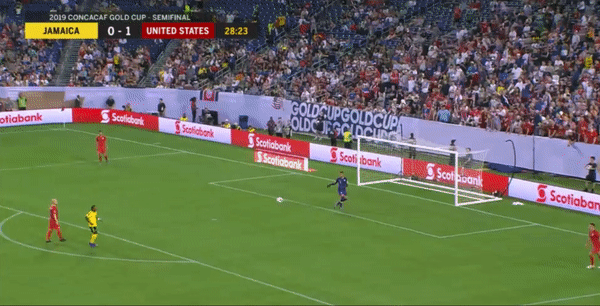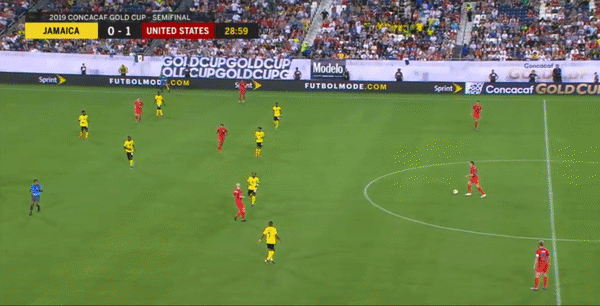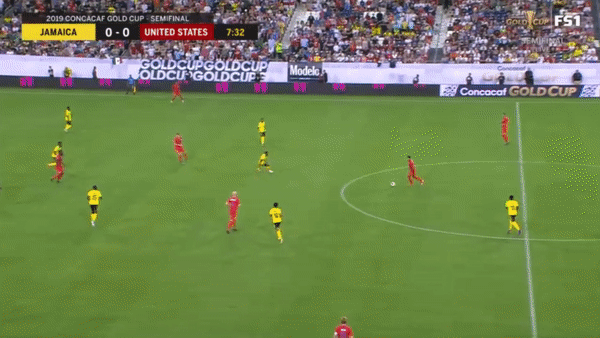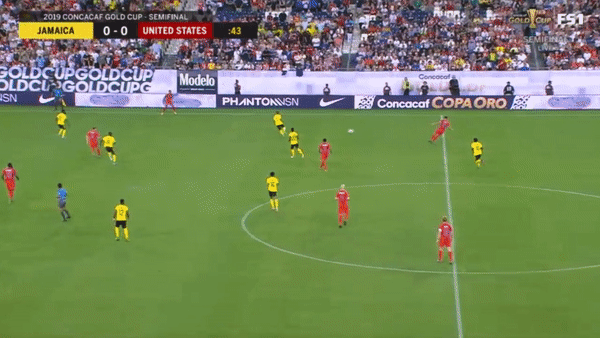How a Gold Cup semifinal masterclass showcased Weston McKennie's growth

NASHVILLE — Let’s begin with a play you didn’t even see.
It was minute 28. TV cameras had strayed. A murmur squirmed through Nissan Stadium. And Weston McKennie was shouting.
His arms were outstretched. Eyes wide and full of intensity. Body bobbing up and down like an impatient child who needed attention – because, well, that’s exactly what McKennie wanted.
His U.S. teammates had just bungled an attempt to build from the back in Wednesday’s Gold Cup semifinal. McKennie had “an idea of how we could play out.” He just needed to communicate it. So he took control. Gestured animatedly. Directed a player more than a decade his senior. Helped orchestrate an adjustment from the heat of battle that, even if only for a fleeting moment, had the U.S. men’s national team looking like Pep Guardiola’s Manchester City.

“Tim [Ream] was open,” McKennie explained to Yahoo Sports postgame. “And I was tryna tell him to push up, and let Zack [Steffen] play that ball.” After going short 30 seconds earlier, putting Aaron Long under unreasonable pressure, “I think we all realized how we could get out of that situation.”
McKennie did a lot with the ball during a 3-1 USMNT win over Jamaica. He scored it. Distributed it. Chased it. Captured it.
But head coach Gregg Berhalter already knew the 20-year-old from Dallas’ suburbs could do those things. “Weston is an outstanding player,” Berhalter said postgame. “He’s a real talent.
“What we’re working on with him is the positional play. We’re working on the smaller movements.” The understanding. The awareness.
And after just his first extended period working with Berhalter, he is lapping up the details. Making the box-to-box midfield role in an evolving system his. Digging into the nuance. “Starting to get the hang of it,” as he said postgame. Which is a frightening proposition for U.S. opponents.
How Weston McKennie bossed Jamaica
McKennie opened the Gold Cup as something close to a No. 10. He was pushing high, lurking in between lines, looking to receive a forward pass on the half-turn and play another one. It’s a role he enjoys – “that’s what I like to do,” he said after the tournament opener – but one that constrained him.
Since, he has dropped deeper, from a Christian Pulisic-adjacent position to more of a Michael Bradley-adjacent one. And it has unleashed him. Opened up his soccer toolbox.
On Wednesday against Jamaica, he pulled out all the tools. He sunk into a No. 6 position and sprayed the ball around the field:

PULISIC MAKES IT ✌️
He fires home the rebound off Jordan Morris's shot and doubles the @USMNT's lead 💪🇺🇸 #GoldCup2019 pic.twitter.com/qgZdUG9Bqi— FOX Soccer (@FOXSoccer) July 4, 2019
He got on it in more advanced positions and picked out killer passes:

He also exploded into the box to get on the end of final passes ...

... and put one in the back of the net:
WESTON MCKENNIE! 💪🇺🇸
A beautiful team goal right there by the @USMNT 👏 #GoldCup2019 pic.twitter.com/8XkzMO5JAD— FOX Soccer (@FOXSoccer) July 4, 2019
I asked Berhalter postgame whether McKennie’s forays forward are systematic or instinctual. “When we play him as a 10, it’s very specific when we want him getting into the penalty box,” Berhalter explained. The movements and their triggers, when McKennie’s starting position is higher, are more defined.
But “we played him a little deeper today in buildup,” Berhalter continued. “That’s him picking those moments [to get forward]. He’s very good at that. Very dynamic runner. As the ball’s wide, he sees where the space is and attacks it.”
The positional tweak – it’s not a full-blown change – has therefore given McKennie more flexibility and freedom to influence the game as he sees fit.
Familiarity has also empowered him. “Coming from Schalke, I played a lot of positions this past season,” McKennie said. “Learning [Berhalter’s] system, and getting used to it, it’s gotten better over time.
“When I first got in, I was a little fresh on the new system that we were playing.” Now, McKennie says, “I think I’ve gotten a little more comfortable in the position, and more confident. Now I’m starting to move a lot more, and move around the field, and be more active, instead of staying in one spot.”
Heck, moments after he played that diagonal to Paul Arriola (above), he was arriving in the box:

Says Bradley of his midfield partner’s growing comfort: “I think his personality starts to come out more and more.”
A full month with the national team has also allowed McKennie’s playmaking qualities to bubble to the surface more and more.
“The system we have, we’re all connected,” he said Wednesday night. “We make it predictable for ourselves – not opponents, but for ourselves – on where options are, and where we can play the next pass. And it makes it easier on us. There were a couple balls today I played one-touch … you know where players are gonna be.”
There’s a bigger picture to all of this as well. McKennie needed that predictability. Throughout professional men’s soccer, it is often clubs, not national teams, that are breeding grounds for this type of comfort-driven growth. For McKennie, though, the 2018-19 season was relegation-threatened and rocky. Almost none of it was his fault. But his development, plagued by coaching turnover and constant positional tinkering, suffered as a result.
McKennie, in a way, needed the national team this summer. Needed the consistent, tactically-focused training. Needed the coherent teaching. After a month of it, he once again looks destined for stardom. On Wednesday night, he was already there.
* * * * *
Now, onto a few other notes from the USMNT’s semifinal victory ...
How Jozy changes the USMNT
Wednesday was Jozy Altidore’s first start with a first-string USMNT since Couva. And in a little over 50 minutes, he reminded us all why he should be the team’s undisputed No. 9.
He didn’t get a goal. Didn’t set one up. But he changed the U.S. for the better. His ability to drop into the hole and essentially become the team’s No. 10 is so crucial. It allows Pulisic, the nominal 10, to run into wide areas ...
I motion that we call an inside-out run from a central player the "Pulisic run" from now on. Cc: @HenryBushnell pic.twitter.com/X8xQrR6SNU
— Joseph Lowery (@joeInCleats) July 4, 2019
... and Jordan Morris – or Tyler Boyd – to run out-to-in from the right wing.
The patterns can take shape when the ball finds Altidore in the air or on the floor, from a variety of angles:

That Altidore can do all this better than any other striker in the player pool makes him a must-start – including on Sunday in the final. But his impact is even more extensive. He allows other U.S. attackers to do what they do best.

Pulisic’s deception
Pulisic was the second best player on the field. He bagged two goals. I asked him afterward whether he felt it was his best game yet under Berhalter. (I thought it was.)
“No, not at all,” he responded. “I don’t think I was very clean all night, my final pass wasn’t great. There was a lot of times I didn’t make the right decisions in the final third.”
Some of which is true. But, uh ...
dufskekhdawfelfijnsdqwahkb pic.twitter.com/tZWboJU0wR
— Henry Bushnell (@HenryBushnell) July 4, 2019
It wasn’t just the goals, or that sideline sorcery. Pulisic, on several occasions, ran Jamaica ragged down the U.S. left. We’ve already detailed how his USMNT role involves interchanging with Arriola to find space. He did a lot of that – and it even helped make the first goal.
But so much of his brilliance, of course, is what he does with that space. He has this rare ability to deceive defenders: He baits them into trying to get tight to him, as all defenders are taught to do. But at the moment they betray themselves and sacrifice balance, he skips by them and accelerates away.

Sure, the end product could use a bit of work. But Pulisic was superb on Wednesday.
Let’s gush about that Michael Bradley diagonal
I can’t say enough about Michael Bradley’s 50-yard diagonal in the buildup to the first goal. It’s emblematic of his one still-elite skill. And it was gorgeous.
WESTON MCKENNIE! 💪🇺🇸
A beautiful team goal right there by the @USMNT 👏 #GoldCup2019 pic.twitter.com/8XkzMO5JAD— FOX Soccer (@FOXSoccer) July 4, 2019
A few weeks ago in Minnesota, I asked Bradley about the process behind those passes. “There’s timing, for sure,” he said. “There’s understanding, on a given play, where space is. Where are we on the field? Is it an opportunity where we can start a little wider and be moving directly inside toward the goal? Is it in a part of the field where they’re just going to stay a little wider, and now we use it as a way to open things up?
“It’s timing, it’s relationships, it’s feel. All of those things.”
And Wednesday’s ball was all of those things. Cannon’s timing was great. But the initial angle of his run called for a ball inside or over the fullback – the out-to-in concept Bradley discussed above. The Toronto FC general, however, recognized there was no window for such a ball. So he kept it wide of the fullback. Cannon adjusted mid-flight. Seconds later, McKennie and the U.S. grabbed a lead they wouldn’t relinquish.
– – – – – – –
Henry Bushnell is a features writer for Yahoo Sports. Have a tip? Question? Comment? Email him at henrydbushnell@gmail.com, or follow him on Twitter @HenryBushnell, and on Facebook.

